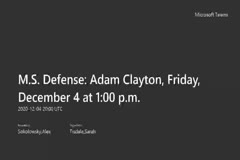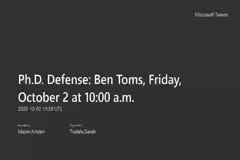Defenses for Fall 2020

ANALYZING THE DETECTION EFFICIENCY OF THE GEOSTATIONARY LIGHTNING MAPPER IN ISOLATED CONVECTION
December 04, 2020
Adam Clayton
The Geostationary Lightning Mapper (GLM) flying on GOES-16 and GOES-17 has provided near-hemispheric lightning detection for nearly two years. Since operation began, several attempts have been made to compare flash rate observations from GLM against ground-based lightning detection systems. While GLM captures a high percentage of flashes in the field-of-view of GOES-16 and GOES-17, some studies…

USING GOES-16 ABI DATA TO DETECT CONVECTION, ESTIMATE LATENT HEATING, AND INITIATE CONVECTION IN A HIGH RESOLUTION MODEL
November 30, 2020
Yoonjin Lee
Convective-scale data assimilation has received more attention in recent years as spatial resolution of forecast models has become finer and more observation data are available at such fine scale. Significant amounts of observation data are available over the globe, but only a limited number of observations are assimilated in operational forecast models in the most effective way. One of the…

ON INTENSITY CHANGE AND THE EFFECTS OF SHORTWAVE RADIATION ON TROPICAL CYCLONE RAINBANDS
October 28, 2020
Benjamin Trabing
In this dissertation, the effects of shortwave radiation and the diurnal cycle of radiation on tropical cyclone rainbands are explored. In order to improve short term forecasts of tropical cyclone intensity and size, a better understanding of the processes that affect the inner rainbands of tropical cyclones is warranted. In Part I, the distribution of intensity forecast errors from the…

Airborne Radar Quality Control and Analysis of the Rapid Intensification of Hurricane Michael (2018)
October 27, 2020
Alexander DesRosiers MS Defense
Improvements made by the National Hurricane Center (NHC) in track forecasts have outpaced advances in intensity forecasting. Rapid intensification (RI), an increase of at least 30 knots in the maximum sustained winds of a tropical cyclone (TC) in a 24 hour period, is poorly understood and provides a considerable hurdle to intensity forecasting. RI depends on internal processes which require…

Towards Using Neural Networks for Geoscientific Discovery
October 02, 2020
Benjamin Toms
How can we use computational methods to extract physically meaningful patterns from geoscientific data? This question has been asked in some form for decades within the geoscientific community, with many landmark discoveries resulting from the novel application of computational methods to a geoscientific dataset. Many methods exist to discover patterns within geoscientific data, although each…

ENVIRONMENTAL CONTROLS AND AEROSOL IMPACTS ON TROPICAL SEA BREEZE CONVECTION
August 28, 2020
Minnie Park
Original resolution. Nearly half of the world's human population resides within 150 km of the ocean, and this coastal population is expected to continue increasing over the next several decades. The accurate prediction of convection and its impacts on precipitation and air quality in coastal zones, both of which impact the health and safety of all…

Daytime Evolution of Oxidized Reactive Nitrogen in Western U.S. Wildfire Smoke Plumes: In situ and Satellite Observations
August 25, 2020
Julieta Juncosa Calahorrano
Also: original resolution. The Western Wildfire Experiment for Cloud Chemistry, Aerosol Absorption, and Nitrogen (WE-CAN) deployed the NSF/NCAR C-130 aircraft in summer 2018 across the western U.S. to sample wildfire smoke during its first day of atmospheric evolution. We present a summary of a subset of oxidized nitrogen species (NOy)…

INTRASEASONAL AND DIURNAL VARIATIONS OF PRECIPITATION FEATURES OBSERVED DURING DYNAMO
August 06, 2020
Marquette Rocque
Also, you can download the videos at the original resolution. The diurnal cycle (DC) of rainfall over the tropical oceans and within the Madden–Julian oscillation (MJO) has been investigated in numerous studies, but there has been limited research on how the DC of precipitation and convective organization evolve throughout phases of the MJO.…
